

It would seem that it could be better: you sit in a warm room, make flower arrangements, enjoy the contemplation of roses and lilies, communicate with fat cats, bewitched by the beauty created by your hands. But this is only the visible side of the phytodesigner's profession - his work is much harder than it seems from the side.
Plants should fit the room in size and shape.
A spreading palm or a ficus will require space so that their impressively stretched branches make the proper impression. For a small apartment, compact dracaena, hanging ivy or succulents are more suitable. Small plants, for example, Saintpaulias, look more effective in groups. For making compositions from several plants take the same pots.
For the design of office space with a strict business environment, choose large spectacular plants - palm trees, citrus, banana tree, anthuriums, large ferns.
Ferns always make a compelling impression. Their fronds can be delicate and delicate, chic and elegant, dense and leathery.
Standard apartments become much more comfortable when their owners arrange small green or flowering islands on the shelves or on the tables.
It can be, for example, flowering or variegated plants that do not lose their decorative effect all year round. Decorative-leafed plants: Benjamin's ficus, sparmannia, Radermacher's palm tree resemble trees as a growth form, and, as a rule, they are solo.
Classic imitation plants include, of course, ivy, which plants almost all interiors.
Sturdy and diverse, they can be used independently, and, of course, be a decoration of the composition.
Что бы оставить комментарий войдите
Комментарии (0)